Guest geology by David Middleton
One of the coolest things about writing posts for WUWT is the fact that, quite often, a ridiculous comment will form the nucleus of a subsequent post…
Why the Oil Industry Cannot Afford to Retire… Yet!
Published on September 11, 2017Greg Rogers
Accounting for Climate ChangeThis is the first in a two-part series on the emerging climate-related financial risk of unfunded oil and gas asset retirement obligations.
The oil industry may be nearing retirement sooner than expected. As reported by Bloomberg, the International Energy Agency (IEA) estimates that by 2040 efficiency improvements could eliminate the need for about 11.6 million barrels of oil demand a day. Adoption of electric vehicles could take away another 5.2 million barrels per day, and widespread switching to alternatives including natural gas and biofuels could displace about 13.5 million barrels a day.
All these things together, which the IEA says will be required to limit global warming to the 2°C target under the Paris Agreement, indicate that oil demand will peak around 2020 and by 2040 decline by about 20 million barrels a day. That’s 36 million barrels a day (13.14 billion barrels a year or $657 billion a year at $50 per barrel) less than the average oil company forecast for 2040—a gap larger than OPEC’s current production. Some oil companies have acknowledged this possibility. Shell believes oil could peak somewhere between 5 and 15 years, while Total sees a surge in battery powered vehicles causing demand for oil to peak in the 2030s.
The possible early retirement of the oil industry is a risk for investors. But there’s another problem… the oil industry cannot afford to retire. When the oil industry retires it will have to pay massive unfunded statutory liabilities to decommission production assets and restore the environment.
[…]
LinkedIn
Since Greg, the climate accountant, doesn’t know Jack Schist about reality, he assumes that demand will drop, prices will crater and companies will be forced to shut in producing assets, without the ability cover abandonment and retirement obligations (ARO), because climate change.
Corona virus notwithstanding, crude oil demand will continue to rise for decades, even if at a slowing pace, so his idiotic scenario won’t play out… However, even when producing properties become uneconomic, there’s almost always a lower cost operator eager to pick up assets and assume the ARO. And then there are companies that specialize in abandonment work who will gladly take over the assets, often paying little more than assuming the ARO. I used to call companies like these “bottom feeders”, before I figured out that bottom feeding can be quite rewarding. Few things are more fun than tearing apart an old field and figuring out what the previous operators missed… Sometimes it’s a lot.
Greg, the climate accountant, wasn’t satisfied with being ignorant, he then went full-retard…
Industry consultant IHS Markit forecasts that spending on global decommissioning projects will increase 540% from approximately $2.4 billion a year in 2015 to $13 billion annually by 2040, a 7.0% compounded annual growth rate. Total decommissioning payments between 2010 and 2040 are estimated to be $210 billion.
LinkedIn
I guess he thinks $210 billion over 30 years for an entire industry is an insurmountable expense. That’s a paltry $7 billion/yr. Texas, just the state of Texas, generated more revenue than that, twice as much in some years, from taxes and royalties on oil & gas production.

The oil and gas resources of just the Permian Basin are estimated to be worth $25 to $100 trillion. $7 billion/yr, industry-wide, isn’t even a rounding error.
H/T to “bigoilbob” for then conflating the “Taylor oil spill” with orphaned and otherwise improperly abandoned wells, providing a perfect segue. I had been thinking about writing a post on this since I wrote Deepwater Horizon: EpiLLOG back in 2017, I just never got…

The 100-yr Oil Spill
This Oil Leak Could Last for 100 Years — and the Company Involved Refuses to Fix It
by Tim DonaghyFebruary 19, 2016
Far away from TV cameras and under the radar of the nightly news, oil has been continuously leaking from a damaged production platform located just 12 miles off the coast of Louisiana in the Gulf of Mexico — causing oily sheens on the surface that stretch for miles and are visible from space.
The Risks of Offshore Oil Production
In September 2004, Hurricane Ivan slammed into the Gulf and unleashed an underwater mudslide which toppled the Mississippi Canyon 20 (MC20) oil platform. The offshore platform was located in 450 feet of water near the outlet of the Mississippi River. After the mudslide, the platform ended up on the seafloor, 900 feet from its original location, and plumes of oil began seeping from the broken well casings of more than 20 wells that had been connected to the platform.
Although the company began working to contain the leak, the mudslide made traditional well containment tactics difficult. Taylor Energy was more effective at keeping the oil spill under wraps and information about it was not made public until 2010, when BP’s Deepwater Horizon disaster brought added scrutiny to the region. While reviewing satellite imagery of BP’s oil slick, the watchdog group SkyTruth noticed a smaller slick coming from the MC20 location. Measuring the size of the oil slick in satellite images, SkyTruth was able to estimate a leakage rate ranging from 37 to 900 gallons per day. Over the years, that rate adds up to between 300,000 and 1.4 million gallons of oil spilled into the Gulf.
[…]
Greenpeace
Note to Greenpeace: Oil is measured in barrels, not gallons. 37 gallons is less than 1 barrel and the “company involved” has done, and continues to do, everything possible to “fix it”.
A 14-year-long oil spill in the Gulf of Mexico verges on becoming one of the worst in U.S. history
By Darryl Fears Oct. 21, 2018 at 5:07 p.m. CDT
NEW ORLEANS — An oil spill that has been quietly leaking millions of barrels into the Gulf of Mexico has gone unplugged for so long that it now verges on becoming one of the worst offshore disasters in U.S. history.
Between 300 and 700 barrels of oil per day have been spewing from a site 12 miles off the Louisiana coast since 2004, when an oil-production platform owned by Taylor Energy sank in a mudslide triggered by Hurricane Ivan. Many of the wells have not been capped, and federal officials estimate that the spill could continue through this century. With no fix in sight, the Taylor offshore spill is threatening to overtake BP’s Deepwater Horizon disaster as the largest ever.
[…]
The Washington Post
Note to Darryl Fears of The Washington Post: Apart from that possibly being the two stupidest paragraphs ever written, 2008-2018 isn’t 14 years, gallons and barrels aren’t synonymous, all of the wells were as properly plugged and abandoned (P&A’ed) as possible and no oil has been “spewing” into the Gulf.
An oil spill that began 15 years ago is up to a thousand times worse than the rig owner’s estimate, study finds
By Harmeet Kaur, CNN
Updated 3:28 PM ET, Sat June 29, 2019
(CNN) For 15 years, oil from one particular spill has been leaking into the Gulf of Mexico.
A new federal study estimates that each day, about 380 to 4,500 gallons of oil are flowing at the site where a company’s oil platform was damaged after a hurricane. That’s about a hundred to a thousand times worse than the company’s initial estimate, which put the amount of oil flowing into the ocean at less than three gallons a day.
The report, released this past week and written by scientists at the National Oceanic and Atmospheric Administration and one at Florida State University, also contradicted assertions from the Taylor Energy Company about where the oil was coming from.
[…]
CNN
Note to CNN’s Harmeet Kaur (if that is your real name): Rig? What “rig”? And no oil is “flowing.” The exaggerated estimate is also up to 1,000 times the US Coast Guard’s previous estimate and up to 100 times the maximum volume ever actually measured.
Of those three incredibly stupid articles, Darryl Fears, unsurprisingly, takes the cake for the stupidest, by a wide margin.
An oil spill that has been quietly leaking millions of barrels into the Gulf of Mexico has gone unplugged for so long that it now verges on becoming one of the worst offshore disasters in U.S. history.
Between 300 and 700 barrels of oil per day have been spewing…
Darryl Fears… “You can’t fix stupid.”
Fears’ article was actually dumber than the comment that inspired me to write this post.
Based on media reports, it would be easy to conclude:
- Taylor Energy is a clandestine oil company that hid evidence of a massive oil spill from the government.
- Taylor Energy refused to take action to control the spill.
- Taylor Energy went bankrupt leaving “many of the wells” unplugged, and taxpayers on the hook.
- The Taylor Energy oil spill rivals the magnitude Deepwater Horizon disaster.
- The Taylor Energy oil spill is just the “tip of the iceberg” of improperly plugged & abandoned wells, orphaned by bankrupt oil companies… And climate change worsen this situation.
None of the above bullet points are even remotely close to the facts… But, all are part and parcel of Imaginary Tales of Conflation.
The MC 20 Oil Discovery
MC stands for Mississippi Canyon. The federal leases in the Gulf of Mexico are grouped into geographic areas that are the equivalent of onshore states and counties. Mississippi Canyon is a nominally deepwater “county” in offshore Louisiana (Central Gulf of Mexico). It is named after one of the most prominent bathymetric features in the Gulf: The Mississippi Canyon.
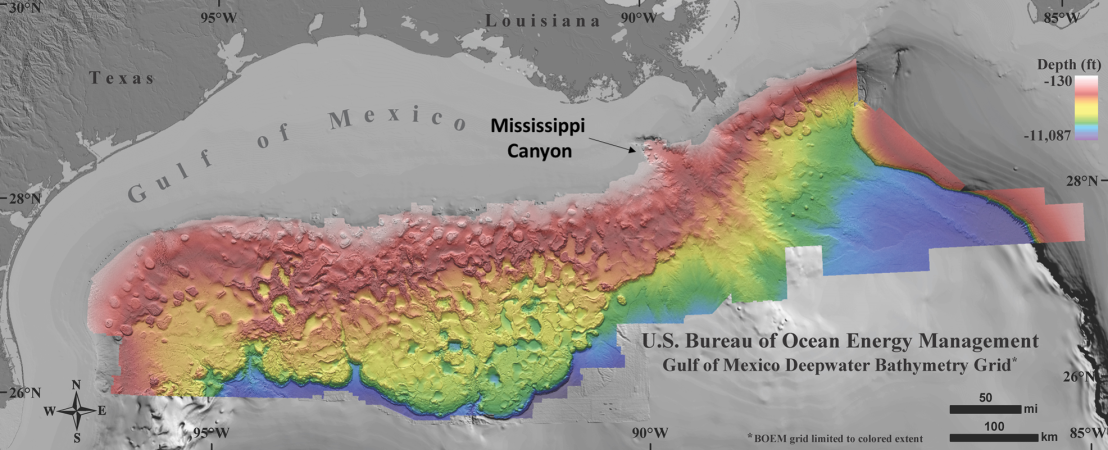
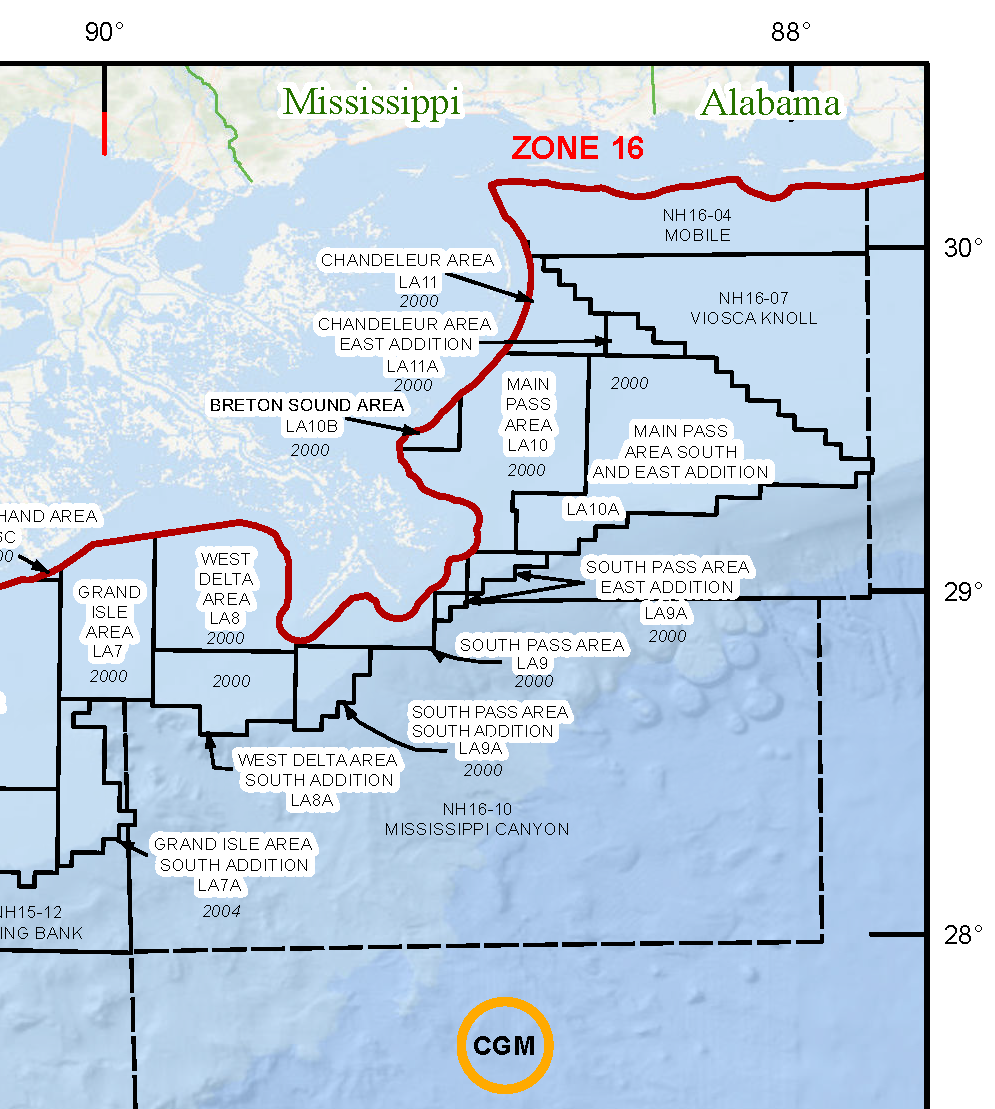
MC 20 is on the very northern edge of Mississippi Canyon. With an average water depth of 466′, it is technically not a deepwater lease.

MC 20 was orginally leased by BP subsidiary, Sohio, in 1981, with a winning bid of $133,750,000. The discovery well was drilled in 1982, the “A” platform was set in January 1984 and went on production in December 1984. It was called the “Saratoga” field. BP sold Saratoga to privately owned Taylor Energy in the 1990’s. From 1984-2004, the field produced 12.6 million barrels (mmbbls) of oil and 24.1 billion cubic feet (Bcf) of natural gas from Lower Pleistocene and Pliocene reservoirs on MC 20 and MC 21. The platform was toppled by a mudslide in the aftermath of Hurricane Ivan in 2004.
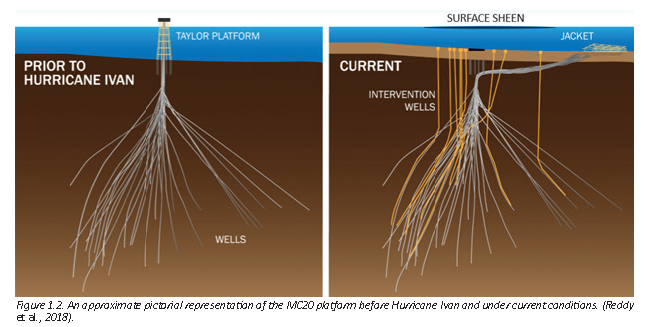
Of the 27 wells drilled from the platform, 15 were still producing and 12 had been plugged & abandoned (P&A’ed). At the time, there was no evidence of oil or gas flowing out of the contorted bundle of risers.
In 2005, Taylor Energy installed the “B” platform on MC 21. From 2005-2019, it produced another 12 mmbbl of oil and 24 Bcf of gas. However, in 2008, an intermittent oil sheen was reported over the site of the toppled “A” platform. Taylor Energy drilled 11 intervention wells to effect downhole plugging of the wells that may have still been capable of flowing oil, decommissioned the oil pipeline, cleared as much debris from the seafloor as possible and began weekly overflights to measure the extent of the oil sheen.
Taylor Energy sold its oil & gas assets in 2008 and has since existed solely to respond to government demands.
In 2004, as Hurricane Ivan – the 10th most intense Atlantic hurricane on record – passed through the Gulf of Mexico, a massive seafloor slope failure swept away Taylor Energy Company’s oil production platform located in the Mississippi Canyon area, Block 20 (MC-20). Since then, Taylor Energy has been committed to a safe and effective response to protect the environment.
Taylor Energy exists today solely to address this incident. In 2008, the company sold all of its oil and gas assets and entered into a contract with the government under which Taylor Energy funded a Trust with $666 million to secure the performance of specific well and facility Decommissioning obligations at MC-20. Separate from the Trust, the company continues to fund Response efforts, including monitoring by overflights, conducting comprehensive scientific studies of site conditions, making response assets ready for deployment and constructing containment domes located onshore for deployment should a change in conditions warrant their use.
The Collaborative Response
For more than a decade, a Unified Command, comprised of Taylor Energy, the U.S. Coast Guard and the Bureau of Safety and Environmental Enforcement (BSEE), had worked together in the response effort to plug wells, capture residual oil, and conduct extensive studies. Over the course of this time, Taylor Energy spent roughly $480 million to successfully plug wells, install a containment system, monitor the site, maintain readiness capabilities, and perform scientific studies to evaluate site conditions.
The Scientific Consensus
In 2013, scientists from 21 federal and state agencies, as well as leading experts from the private sector, concluded that performance of further decommissioning activities at the site poses the risk of causing far more environmental harm than good. Multiple scientific reports also conclude the sheen on the water’s surface is caused by remnant oil seeping from contaminated sediment on the seafloor. The best, safest solution is not to risk an active release from a well by attempting any further plugging and not taking actions that would disturb the sediments and release trapped oil into the water column. The appropriate response posture is to monitor the site and maintain readiness capabilities while allowing for natural attenuation to gradually reduce the sheen and for sedimentation to encapsulate the trapped oil.
The Resolution
With the consensus that further decommissioning activities pose the risk of causing far more environmental harm than good, Unified Command’s response posture had been to monitor the sheen while being ready to mobilize should conditions change. Taylor Energy is committed to protecting the environment and meeting all of its obligations as the current Responsible Party.
The Government’s About Face
In 2018, a deeply-flawed report, commissioned by the government for litigation purposes and not to guide the Unified Command’s response, wildly exaggerated the volume of oil released per day. The flawed analysis claimed the volumes are more than 1,000 times greater than prior consensus conclusions, which were based on the years of data on record compiled by the Unified Command. This misleading and erroneous analysis received wide media coverage, which seemingly prompted the Coast Guard to reverse its position – despite the vast consensus scientific record cautioning against disruption of the site that could cause the release of significant volumes of otherwise contained oil.
The Call to Action
To prevent a potential resulting disaster, Taylor Energy is taking action in an effort to stop the government from triggering increased environmental exposure. This includes legal actions against the Coast Guard and the private contractor hired by the Coast Guard to carry out this potentially environmentally hazardous action.
If left unchecked, the ill-advised actions of the government could damage the environment, including marine life and the Louisiana coastline. Beyond that, these arbitrary actions and disregard of due process to Taylor Energy should give pause to all Americans.
MC20Response.com
Prior to the “government’s about face,” Taylor Energy and the US Coast Guard were in general agreement about the magnitude of the oil seep.
Based on data collected from nearly daily overflights since September 2014, oil sheens have been observed and reported by Taylor Energy to be as large as 1.5 miles wide and 14 miles long, with an average of 1 mile wide and 5.5 miles long, covering an average area of 8 square miles. Over this period, the daily volume of oil discharging from the MC-20 well site has fluctuated between a low of less than one barrel (1 barrel = 42 gallons) to a high of 55 barrels of oil (2,329 gallons). The average reported daily oil volume on the sea surface over the past seven months has been in the range of over 2 barrels (84 gallons); the volume on over 75 days was greater than 1 barrel, including 23 days of volume greater than 3.8 barrels (160 gallons) and 4 days greater than 35 barrels (1,470 gallons). These spill size and volume estimates are based on reports submitted by Taylor Energy’s contractors to the NRC. All NRC reports can be viewed at www.nrc.uscg.mil.
U. S. Coast Guard Fact Sheet, 2015
It’s important to note at this point that there has never been an oil slick, only an intermittent and highly variable sheen. The volume of oil at the sea surface is visually estimated by analyzing the color, opacity, texture and dimensions of the sheen/slick. An oil sheen is considered to be not recoverable. A sheen is best left to evaporate or otherwise dissipate. A slick (>50 microns) is considered recoverable, possibly justifying skimming and/or other efforts to recover or cause it to dissipate.
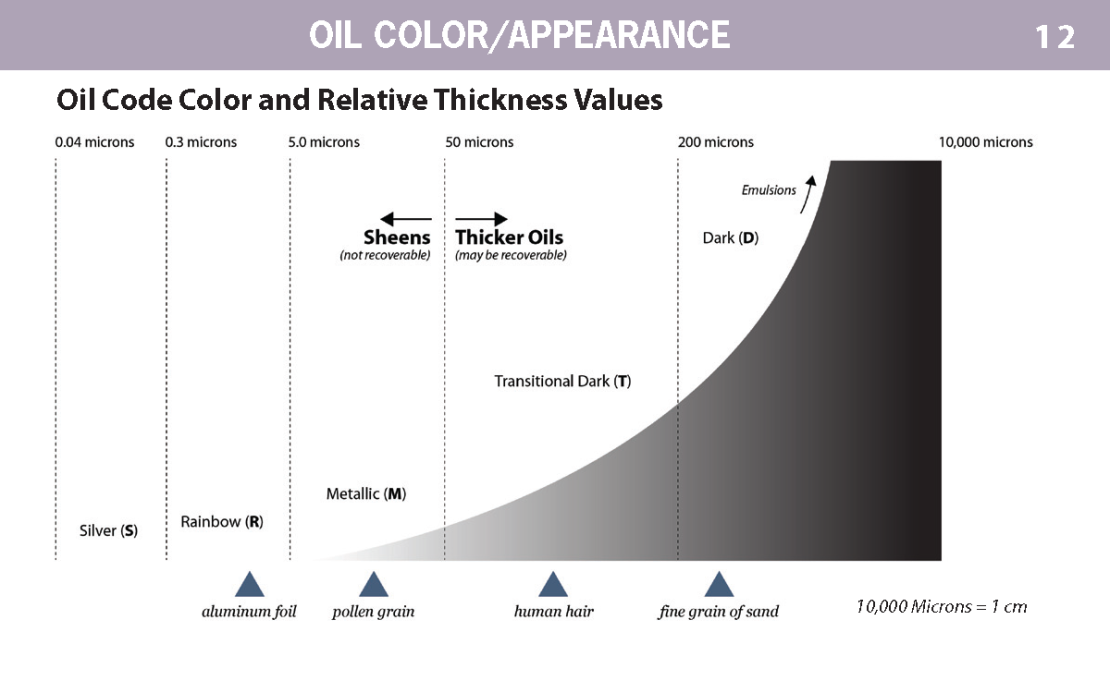
The “deeply-flawed report, commissioned by the government for litigation purposes” is the Department of Justice-sponsored WaterMapping, LLC estimate of about 700 bbl/d. While not as ridiculous as the Sun et al., 2018 estimate of over 1,600 bbl/d (Fears’ source), a flux of such magnitude would cause more than a variable intermittent sheen.
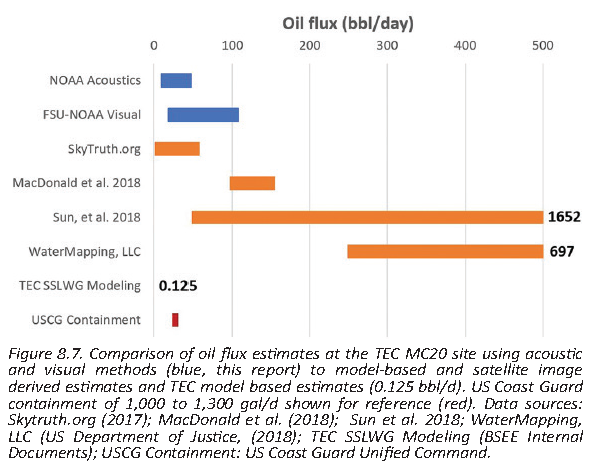
The results of Mason et al., 2019 are the two blue bars at the top. The red bar at the bottom is what the Coast Guard’s containment system has reportedly been collecting ~24-31 bbl/d, far less than the estimates cited by the media. Although the Coast Guard and their contractor, Couvillion Group, have refused to allow any independent verification of their data. The odds are that the USCG volume is an emulsion of crude oil and brine. However, until the USCG allows an independent analysis, we won’t know for sure.
As part of their 2008 agreement with the government, Taylor Energy has spent $480 million responding to the MC 20 oil seep and funded a $666 million trust fund, of which $432 million remains unspent. In 2016, Taylor sued to have those funds released.
Taylor Energy filed a breach of contract lawsuit against the Department of the Interior in January of 2016. The lawsuit is a straightforward contract dispute and does not seek to relieve Taylor Energy of its legal obligations to respond to the MC-20 incident.
In 2008, Taylor Energy entered into a contract with the government pursuant to which Taylor Energy funded a trust account with $666,280,000 to secure performance of a series of specific well and facility Decommissioning obligations at MC-20. Taylor Energy filed the suit to seek the return of its funds that remain in the trust account- a sum of approximately $432 million.
The lawsuit asserts that, despite Taylor Energy’s completion of the last decommissioning obligation the government authorized it to undertake under the contract in July of 2011, the government, in 2015, informed Taylor Energy that its position is that the term of the contract is indefinite and that Taylor Energy’s performance of the remaining decommissioning obligations under the contract will occur, if at all, only at some uncertain and indeterminable future date. The government has also informed Taylor Energy that it intends to withhold indefinitely all of Taylor Energy’s funds that remain in the trust account. Under the applicable law, contracts must be performed in good faith and within a reasonable time. By failing to allow Taylor Energy’s performance of the remaining decommissioning obligations under the contract within a reasonable time while withholding Taylor Energy’s funds in trust, the government breached the contract. The lawsuit further asserts that it is legally impossible for Taylor Energy to perform the remaining decommissioning obligations under the contract because to do so would violate statutory and regulatory mandates that prohibit performance of decommissioning activities that may cause undue or serious environmental harm.
In 2019 a federal court dismissed Taylor Energy Company’s claim against the Department of Interior. Due to numerous factual and legal errors in the Court’s reasoning, Taylor Energy has appealed this action to the United States Court of Appeal for the Federal Circuit. The appeal remains pending.
MC20Response.com
The Bullet Points
- Taylor Energy is a clandestine oil company that hid evidence of a massive oil spill from the government. – FALSE!
- Taylor Energy refused to take action to control the spill. – FALSE!
- Taylor Energy went bankrupt leaving “many of the wells” unplugged, and taxpayers on the hook. – FALSE!
- The Taylor Energy oil spill rivals the magnitude Deepwater Horizon disaster. – Laughably False!
- The Taylor Energy oil spill is just the “tip of the iceberg” of improperly plugged & abandoned wells, orphaned by bankrupt oil companies… And climate change worsen this situation. – Laughably False!
MC 20 and Deepwater Horizon (Macondo)
MC 20 is about 80 km northwest of Macondo.
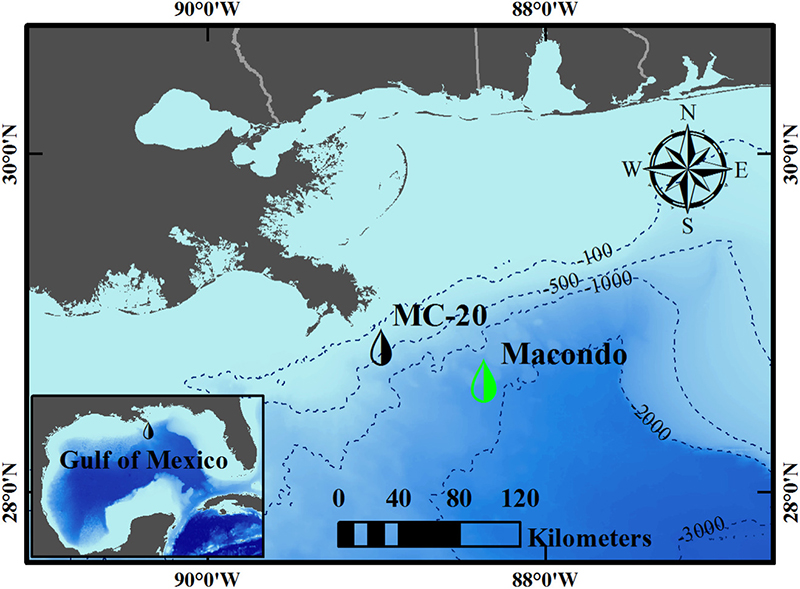
On February 4, 2020, the reported sheen was estimated to be 527 gallons of oil over an area 36 miles long by 10 miles wide. This was, by far, the most significant sheen observed since April 2019.
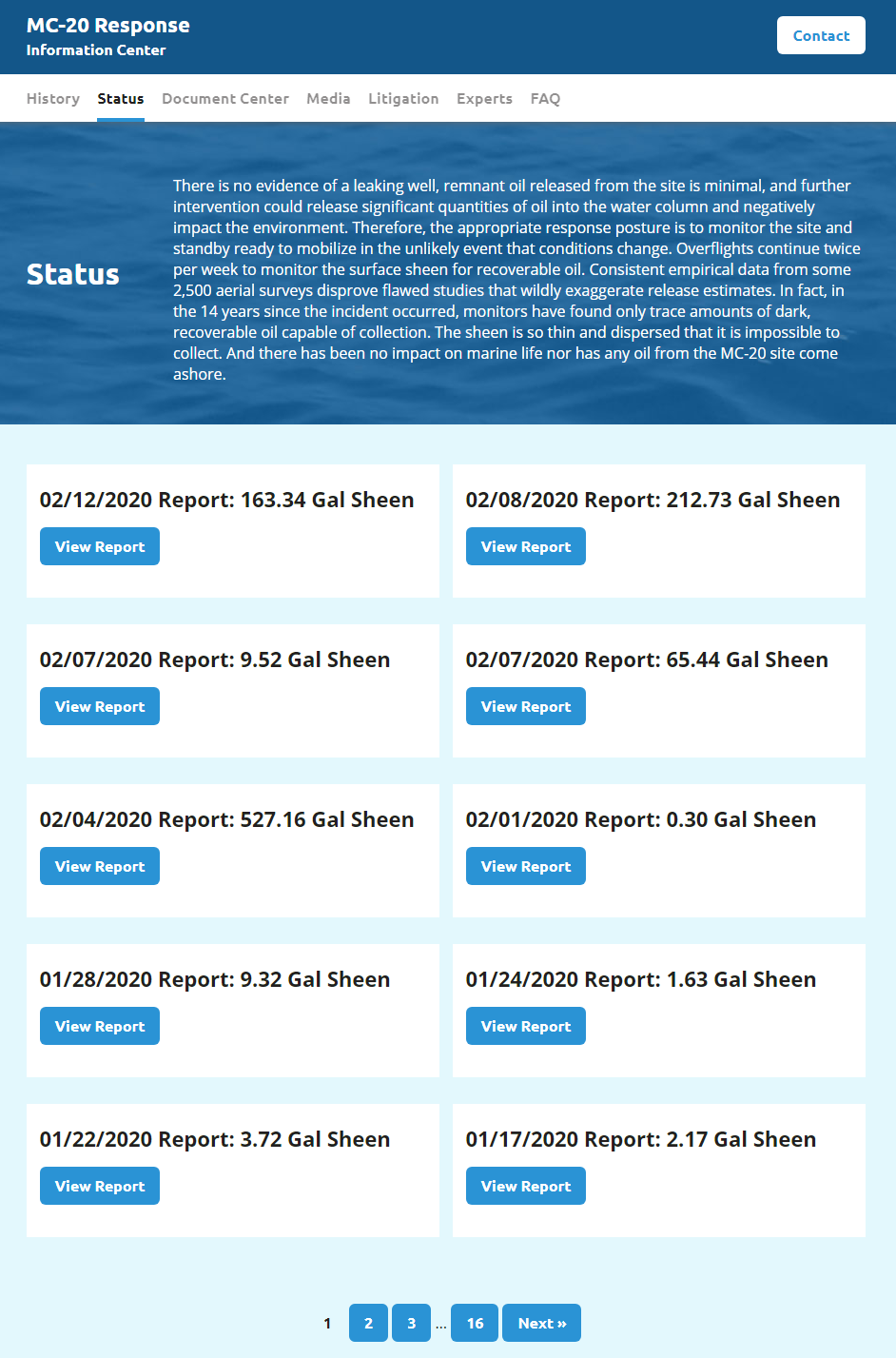
527 gallons over 360 square miles equates to 0.002 m3/km2.
This is a map of known natural oil seeps in the Northern Gulf of Mexico. MC 20 (red star) is right in the middle of the natural oil seep area between the tip of the Mississippi delta and the Deepwater Horizon (DWH) location:

Natural oil seeps in the MC 20 vicinity range from 0.0010 to 0.0025 m3/km2.
Here’s what Macondo looked like.
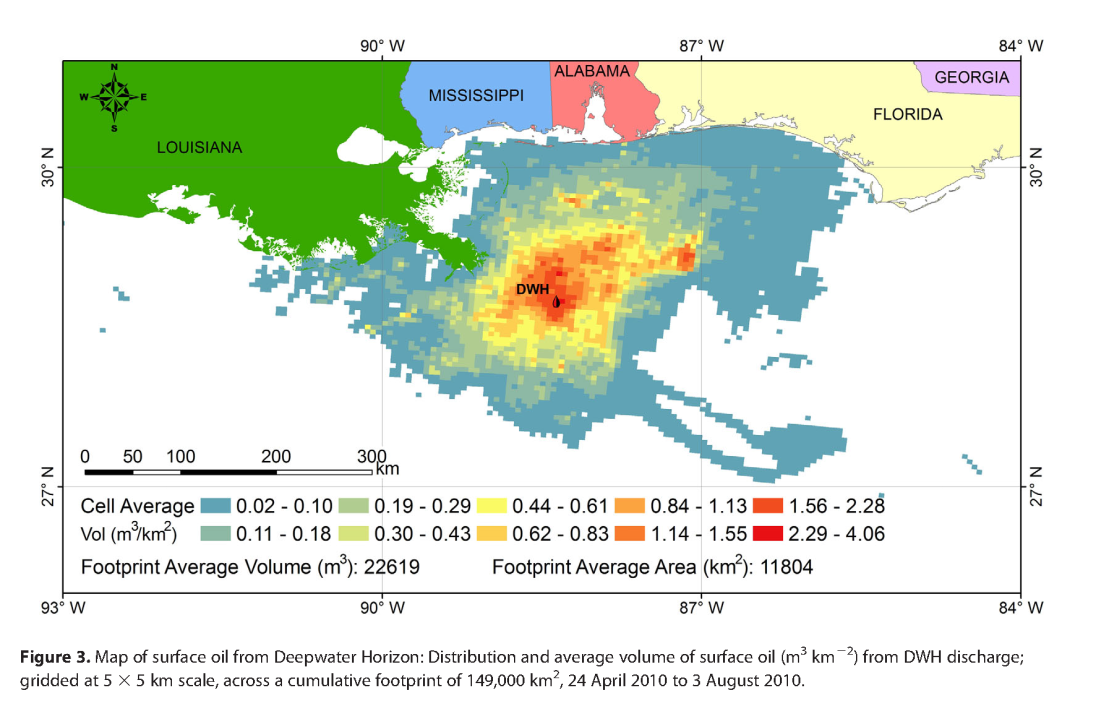
“SkyTruth” was one of the first to hype the MC 20 oil seep.
The estimated cumulative volume of crude oil spilled into the Gulf of Mexico from this chronic leak over the period 2004 – 2017 now stands between 855,421 and 3,991,963 gallons.
BACKGROUND
The Taylor Energy site perfectly captures the dysfunction of offshore oil development: In 2004, an underwater mudslide caused by Hurricane Ivan toppled one of the company’s platforms and buried the damaged wells attached to it on the seafloor. Reports of oil on the surface at the site of the wreckage followed shortly after and a secretive clean-up effort ensued.
SkyTruth
Setting aside the nonsense about perfectly capturing “the dysfunction of offshore oil development” and “secretive clean-up effort”, this works out to 20,000 to 95,000 bbl over 13 years (4 to 20 bbl/d). The Macondo spill was estimated at up to 5 million bbl over 87 days (1,000 to 5,000 bbl/d). Even if the MC 20 seep lasted 100 years, it wouldn’t compare to Macondo.
Let’s assume that the MC 20 seep amounted to 95,000 bbl. The field produced 24 million bbl. This works out to 0.4% Just prior to the Macondo blowout, this was on the MMS (now BOEM) website:
Since 1980, OCS operators have produced 4.7 billion barrels (bbl) of oil and spilled only 0.001 percent of this oil, or 1 bbl for every 81,000 bbl produced. In the last 15 years, there have been no spills greater than 1,000 bbl from an OCS platform or drilling rig. The spill risk related to a diesel spill from drilling operations is even less. During the 10-year period (1976-1985) in which data were collected, there were 80 reported diesel spills greater than one barrel associated with drilling activities, compared with 11,944 wells drilled, or a 0.7 percent probability of occurrence. For diesel spills greater than 50 bbls, only 15 spills have occurred, or a 0.1 percent probability.
Natural seepage of oil in the Gulf of Mexico (unrelated to natural gas and oil industry operations) is far more extensive. Researchers have estimated a natural seepage rate of about 120,000 bbl per year from one area (23,000 square kilometers) offshore of Louisiana.
U.S. Minerals Management Service ca April 2010
The passage disappeared from the website shortly after the blowout, however versions of it can be found in official documents.
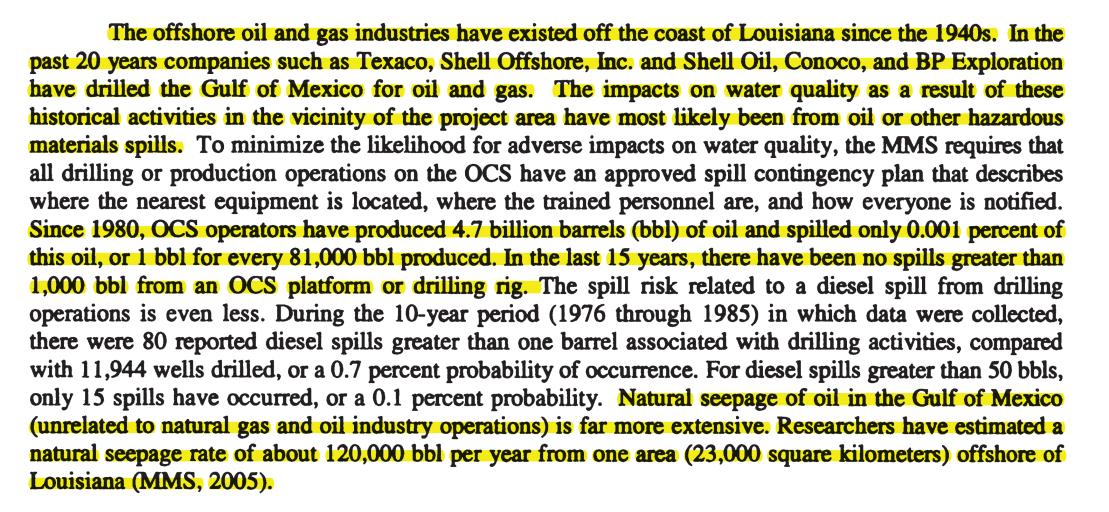
The MC 20 oil “spill” would have been tiny compared to Macondo, but it would have been 40,000 times as bad as the industry’s long-term average. An oil sheen of the same magnitude as nearby natural oil seeps is 40,000 times worse than “business as usual”… Let me know if I need to explain this to you.
Of the nearly 53,000 wells drilled in the Federal waters of the Gulf of Mexico since 1947, there has been one Macondo and there has been one MC 20. Macondo was the result of human errors and the phenomena of “defining deviancy down.” It should have never happened and the industry has taken every step possible to ensure it never happens again. MC 20 was an unavoidable “act of God.” Every human endeavor entails risk.
Relative to the number of wells drilled and volume of hydrocarbons produced, the volume of oil spilled in the history of oil & gas drilling operations in the Gulf of Mexico has been minuscule.

Having trouble seeing the spills? Here’s a logarithmic plot of just the spills and natural seepage estimate:
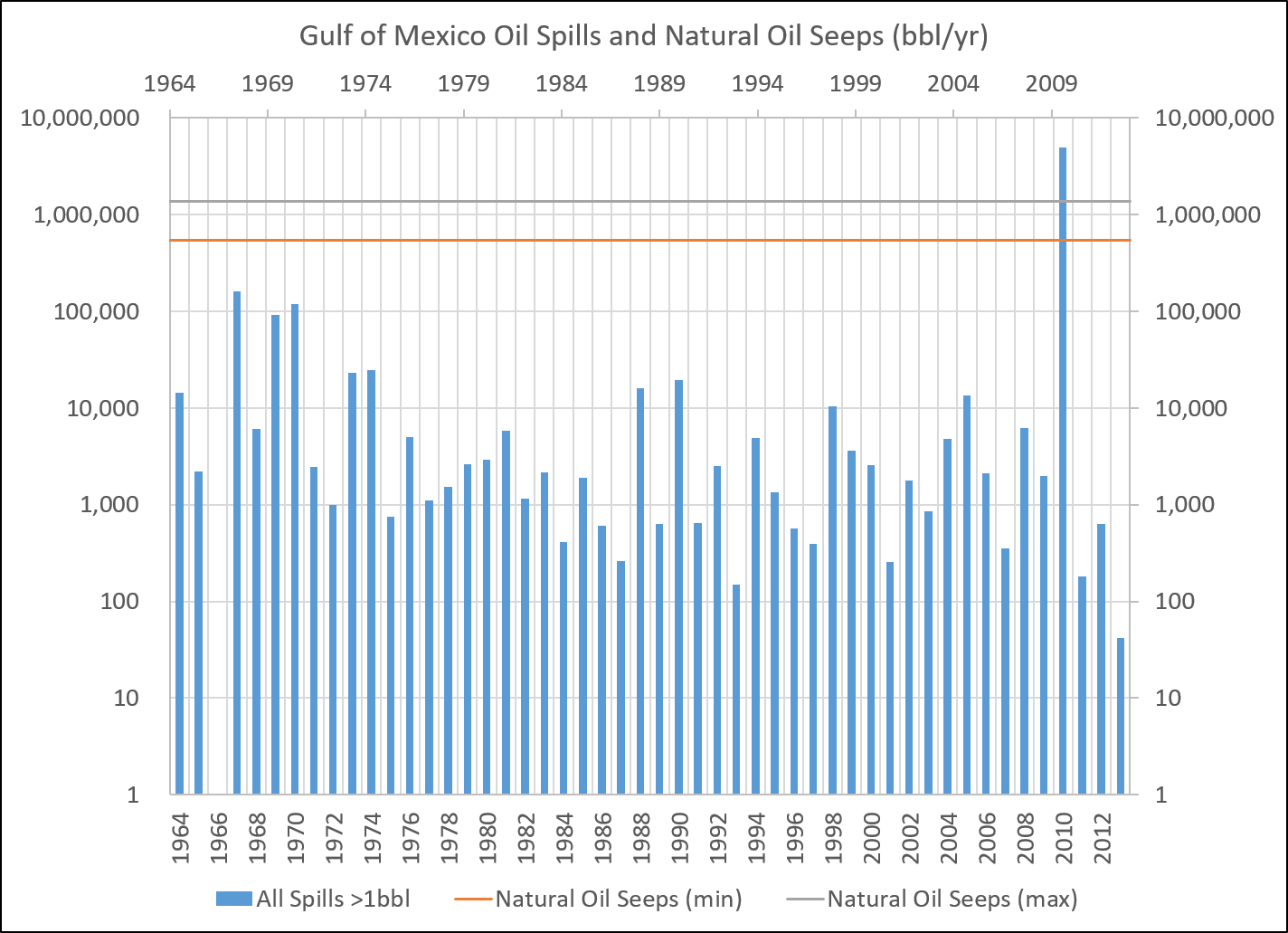
We can clearly see that:
- The MC 20 oil seep is insignificant.
- It is not indicative of improper P&A operations.
Part Deux of this series will take a deeper dive into the nature of the MC 20 oil seep.
Imaginary Tails of Conflation
MC 20 has frequently been conflated with two unrelated oil field problems.
- Improperly plugged and abandoned wells.
- Orphaned wells.
In 2017, there were one million active oil and gas wells in the United States.1 When a well reaches the end of its productive life, or if it fails to find economic quantities of oil or gas, the well operator is required by regulators to remove all equipment and plug the well to prevent leaks.2 Usually, cement is pumped into the well to fill at least the top and bottom portions of the well and any parts where oil, gas, or water may leak into or out of the well. This generally prevents contamination of groundwater and leaks at the surface. State or federal regulators define specific plugging procedures depending on the local conditions and risks, and may monitor the plugging operation.
However, there are many cases in which wells are not properly plugged before being abandoned, especially if the well operator goes bankrupt, leaving its wells “orphaned”.3 This is more common when oil prices fall rapidly, making many wells uneconomical, as in the 1980s oil glut, the 2008 financial crisis, and the 2014 downturn.
In the late 1980s, the U.S. Environmental Protection Agency estimated that 200,000 of 1.2 million abandoned wells may not have been properly plugged.4 Since then, tens of thousands of orphaned wells have been plugged by state and federal regulators, as well as some voluntary industry programs. These efforts are ongoing, and many orphaned wells have yet to be properly plugged. The exact number is not known: some 3.7 million wells have been drilled in the U.S. since 1859,6 and their history is not always well documented. Older wells, especially those drilled before the 1950s, are particularly likely to have been improperly abandoned and poorly documented.
[…]
American Geosciences Institute
Many wells drilled before the 1950’s were improperly P&A’ed. Quite often, their locations weren’t even properly recorded. Occasionally, these are revealed by nearby frac’ing operations.
Hydraulic fracturing uses the high-pressure injection of fluids into oil- or gas-bearing rocks to fracture them and allow oil and/or gas to flow out. The increased pressure in the rocks during this process can push oil or salty water up nearby unidentified or improperly plugged abandoned wells. In one of the more extreme cases of this, the U.S. Environmental Protection Agency cited an abandoned well in Tioga county, Pennsylvania, that produced a 30-foot geyser of brine for more than a week as a result of hydraulic fracturing of a nearby well.10 In addition to these fluids contaminating soil and potentially reaching groundwater, the unexpected pressure release caused by this fluid escape reduces the effectiveness of the hydraulic fracturing operation, so there are both environmental and economic incentives to identify and plug wells near a planned hydraulic fracturing operation.
American Geosciences Institute
This can be a headache when operating in old onshore fields; but not really relevant to modern day P&A standards.
Orphaned wells are much more manageable. Their locations and status are fairly well documented and we pay taxes specifically designed to cover the P&A costs.
For several decades, states have increased enforcement of plugging and cleanup requirements. States generally require a performance bond or other financial assurance from the operator that a well will be plugged and the well site restored. However, bond amounts may not meet the plugging and cleanup expenses if an operator goes bankrupt.11 Most states therefore collect fees or a production surcharge from operators specifically for remediation of orphaned wells and associated surface equipment.12 For example, Pennsylvania adds an orphaned well surcharge to drilling permit application fees,14 while Texas adds a 5/8-cent Oil Field Cleanup surcharge to the state’s 4.6% oil production tax.15 The Oklahoma Energy Resources Board remediates abandoned well sites using voluntary industry contributions amounting to 0.1% of oil and gas sales.16
American Geosciences Institute
We pay a lot of taxes…
From 1984 to 2008, the Railroad Commission of Texas (RRC, the state’s regulatory agency for oil and gas) plugged almost 35,000 orphaned wells, including offshore wells, at a cost of over $163 million.17 In fiscal year 2017, the RRC plugged 918 orphaned wells at a cost of over $11.6 million.18 As of December 2017, there were roughly 10,000 known orphaned wells in Texas that required plugging; the RRC aims to plug 1,500 of these in fiscal year 2018.19
American Geosciences Institute
A whole lot of taxes. From 1984-2008, Texas spent $163 million P&A’ing “orphaned wells”… In 2008, alone, oil & gas operators in Texas paid $8.55 billion in state & local taxes (mostly state) and royalty payments to the State of Texas. In 2017, the state spent $11.6 million on P&A’ing “orphaned wells”, while generating over $11 billion in tax and royalty revenue.

In the case of Texas, the cost to P&A orphaned wells amounts to about 0.1% of the annual taxes and royalties paid by the operators.
Conclusion
Most of media reporting on the MC 20 incident has been the product of intentional lies and/or inexcusable ignorance. Of course, intentional lies and/or inexcusable ignorance are part and parcel of media reporting on the oil & gas industry in general. Wow! I used “part and parcel” twice in one post!
About the author of this WUWT post
I have been a geologist/geophysicist in the “climate wrecking” (oil & gas) industry since 1981. Since 1988, I have been working the Gulf of Mexico. I am a member of the American Association of Petroleum Geologists (AAPG), Society of Exploration Geophysicists (SEG) and Houston Geological Society (HGS).
References
MacDonald, I. R., et al. ( 2015). “Natural and unnatural oil slicks in the Gulf of Mexico”. J. Geophys. Res. Oceans, 120, 8364– 8380, doi:10.1002/2015JC011062. LINK
Mason, A.L., J.C. Taylor, and I.R. MacDonald (eds.). 2019. “An Integrated Assessment of Oil and Gas Release into the Marine Environment at the Former Taylor Energy MC20 Site”. NOAA National Ocean Service, National Centers for Coastal Ocean Science. NOAA Technical Memorandum 260. Silver Spring, MD. 147 pp. doi: 10.25923/kykm-sn39 LINK
Sun, S., C. Hu, O. Garcia-Pineda, V.H. Kourafalou, M. Le Hénaff, and Y. Androulidakis. 2018. “Remote sensing assessment of oil spils near a damaged platform in the Gulf of Mexico”. Marine Pollution Bulletin 136: 141-151. doi: https://doi.org/10.1016/j.marpolbul.2018.09.004 LINK
The offshore oil rigs in the Santa Barbara Channel are well known for the terrible spill in 1969. What you won’t hear is that the extraction over all these decades have dramatically reduced the coastal contamination from natural seeps. When I first started boarding it was required to bring a bottle of baby oil and paper towels to the beach to remove the worst of the tar balls you’d pick up in the sand and surf. The first inhabitants became competent seafarers in no small part to that same tar that allowed them to build seaworthy craft. In more recent times oceanographers have been effusive about the ecosystems that have exploded around the rigs that have been decommissioned.
You and your facts! Big oil baaaad!
Going by memory here:
Wasn’t the 1969 Santa Barbara “spill” attributed to one of the legs of the rig puncturing the shallow “conduit” for a nearby natural oil seep?
No.
https://www.researchgate.net/publication/237637103_The_Santa_Barbara_Oil_Spill_A_Retrospective
Pismo in Chumash language means tar. Pismo beach was tar beach.
That is very interesting. My cousins took me to Pismo Beach. I think that is where we went dune-boarding. That was a long time ago.
@Rob Dawg
“What you won’t hear is that the extraction over all these decades have dramatically reduced the coastal contamination from natural seeps.”
Urban mythology, backed up with an anecdote. Yes, the Monterey formation has been “seeping” for millennia. It’s naturally featured, and is hydraulically coupled with the Pacific ocean through those fractures. In fact, it outcrops on parts of the shoreline. I’ve run dozens of producing well pressure surveys and you can even see the tides on them. But there is NO evidence that producing it has reduced those seeps. Trying to claim that the “nonexistent pressure depletion of Monterey OCS production counteracts the damage of the spills (such as the ’97 Irene spill I helped respond to) is ridiculous…
You might be right about this one.
David
“all of the wells were as properly plugged and abandoned (P&A’ed) as possible and no oil
gashas ever been “spewing” into the Gulf.”Great post…..
Fixed.
Excellent analysis.
David
“Orphaned wells are much more manageable. Their locations
ansand status are fairly well documented and we pay taxes specifically designed to cover the P&A costs.”Fixed.
On Figure 10, the darkest color on the map corresponds to 0.015 m^3/km^2 of oil volume. Since 1 km^2 = one million m^2, this corresponds to an oil sheen thickness of 15 nanometers, or about 0.6 millionths of an inch. If the floating oil is assumed to have a density of 800 kg/m^3, and a molecular weight of 200, such a sheen would be about 20 molecules thick.
The second-lowest color on the map is 1/10 of this thickness, or about 2 molecules thick. Anything less than that would be barely measurable, and extremely difficult to clean up–how is it possible to remove two molecules of oil floating on the ocean?
One at a time? (/Sarc)
On February 4, 2019, the reported sheen was estimated to be 527 gallons of oil over an area 36 miles long by 10 miles wide. This was, by far, the most significant sheen observed since April 2019.
February 4, 2020 ??
Will fix… At least I didn’t write 2010.
Once again, another excellent post by David Middleton. Thanks, David.
Regards,
Bob
Indeed it was excellent – despite the typos and minor errors which even a pedant such as myself missed.
I have learned to ignore them if they don’t trip up my concentration by trying to figure out the true meaning.
I hate typos! Fortunately, I have some solid proofreaders!
Fortunately, I have some solid proofreaders!
Nope. Your proofreaders are horrid – by definition.
🙂
I meant WIWT commentators like Mark Broderick.
I know – I just thought I’d bust you for a conceptual error in addition to the grammatical ones.
Jealousy, I suspect . . .
🙂
@David – The WIWTs of WUWT!
Better than having gassy ones.
Doesn’t ever occur to anyone who has the deepest investments in ‘renewables’?
Great post! Thank you!
re Darryl Fears:
2008-2018 isn’t fourteen yers, but 2004-2018 isn’t far off it…… Unless I’ve got something wrong, which is eminently possible……
Otherwise, not a bad effort!!
There was no seep until 2008…
https://www.bsee.gov/newsroom/library/incident-archive/taylor-energy-mississippi-canyon/fact-sheet
The platform was toppled in 2004. There was no oil sheen until 2008.
Thanks for that clarification. I couldn’t figure where I went wrong.
If the sheen is from the MC 20 oil reservoirs, it spent 2004-2008 working its way up to the seafloor.
As always, thank you Mr. Middleton.
Last month, I read a sublime piece of wisdom, “If it was possible to reason with a socialist, there wouldn’t be any socialists” that was attributed to Clint Eastwood.
I don’t know it the attribution was accurate but the thought is.
Good article…
https://en.wikipedia.org/wiki/Asphalt_volcano
Are these not the underwater version of Alberta’s oil sands? Now discovered in my places. Are they not also responsible for a lot of that sheen and oil slick are hurricanes and deeper water disturbances.
Go get them, David! I like the part where we are at peak oil in 2020 because there will be a conversion to electric vehicles. Where does the electricity for these electric vehicles come from? Flux capacitators with an antenna to capture lightning strikes? The general public has no idea about natural oil seepage, with some exceptions like the surfer dude. Remember my comment about nearly being slimed by a natural discharge in the field in the Neuquen Basin? What an attention getter!
Ron Long: “Where does the electricity for these electric vehicles come from?”,/i>
Dilithium Crystal mining futures are UP!
Although oil spills are not good, there are microbes that eat oil quite effectively. This Scientific American article at least addresses this issue fairly well, but exaggerates the issue by using Liters of Oil, a unit that is absolutely inappropriate for the discussion. This is akin to the renewable energy producers using gal of ethanol to make the volume produces seem massive when barrels and more appropriately, bbl/day, is the best unit.
Meet the Microbes Eating the Gulf Oil Spill
https://www.scientificamerican.com/article/gulf-oil-eating-microbes-slide-show/
The Deepwater Horizon oil spill added roughly 800 million liters of hydrocarbons to the Gulf of Mexico. One quarter of that has been burned, captured or skimmed, according to U.S. government estimates. That leaves the rest for trillions of microbes to feast on—a petroleum cornucopia that first became available April 20 when the oil platform exploded and the spill started.
Did they die of massive starvation after they ate all those hydrocarbons?
David, regardless of your opinion of her writing, the name Harmeet Kaur is a legitimate female Sikh name. Males are given the second name Singh (“Lion”) and females are given the second name Kaur (“Princess”). Sometimes they use Singh or Kaur as a surname because Sikhism, an Indian religion, is supposed to be casteless and Indian surnames indicate caste.
I’m just being obnoxious toward the media in general.
And once again I learn something new by reading WUWT!
Meanwhile, the Climate doesn’t care.
Thanks David.
A big effort and very interesting.
great post David Middleton.
Also of note may be this about natural oil seepage …
From https://www.livescience.com/5422-natural-oil-spills-surprising-amount-seeps-sea.html
Serves me right for taking Fears as founded….. Too much detail, sometimes, for me!
I stand corrected! Keep up the good work!!
In The Netherlands, the government is promoting wind and sun, electrical transport and phasing out of coal fired electricity generation, not realising that this will dramatically increase national gas demand in the next twenty years.
Middleton for President! Eschenbach for Veep! But seriously, very interesting and informative stuff, consistently.
Did you fly both the Phantom and the Aardvark? If so, that’s like the coolest thing ever!
Guilty as charged, m’Lud. But it was always other people flying fast and low and making a lot of noise.
Dr Middleton
Very informative analysis. Are you aware of any paper/report explaining the root cause of this event in detail? I mean how exactly Ivan triggered the land slide?
I don’t know if anyone knows how exactly Ivan triggered the slope failure. However, some of the best oil & gas reservoirs and the Mississippi Canyon itself, are the products of slope failures. Although, these were lowstand slope failures (they occurred during glacial stages, when sea level was 100 m or so lower than it is.)
But, I’ll do some digging. One of the problems with searching for articles and papers on this is the fact that 90% of the returns are idiotic news media and activist articles.
Good report and facts well explained.
A nit-pick. Figure 14. I believe Bar charts should never be used on a log scale. The length of the bar has no meaning, only it’s end point. Dots or whiskers (high-low estimates) should be used instead.
Without a log scale the high-low estimates wouldn’t have been visible.
A log scale is always appropriate when comparing signals that differ by at least an order of magnitude.
Great post, David!
I too, had to find exactly where MC20 is located. Since the general directions given by the lunatic author were clear as mud.
Mississippi River has multiple exits into the Gulf of Mexico.
Having fished from several of the river’s exits, I knew darn well that 12 miles due south of the River’s South Pass was deep water.
Turns out MC20 is approximately 12 miles in a Southeast direction from Southeast Pass, which keeps MC20 in slightly shallower water.
Looks like NOAA supports more daft research projects by the unlearned.
Go to any high siltation spot, push a stick or shovel deep into the muck and pry.
Sheens and gas will escape from the muds and float to the surface.
Now those oil sheens, methane and CO₂ are most likely of recent biological origen.
I was thinking the alleged barrels of ‘contained oil seepage’ were barrels of retrieved containment booms. Making it unsurprising that they would allow outsiders to “see” their data.
Any measure of the natural Oil Seepage off the California coast …?
If it was in the article, I missed it. . . .
JPP
The Gulf of Mexico isn’t close to California.
I understand, but there is oil seepage off the California coast. . .
Jpp
And they won’t put any oil rigs out there now . . .
Offshore California has been restricted to existing production for a long time.
There are oil seeps over most of productive sedimentary basins.
It’s the CA government…
Thanks David, bu no H/T required. because the claimed “conflation” never occurred. My passing along of the Murray article was just a one time example of the potential for millennia of seepage from poor/nonexistent well plugging. The point was not that SOME of these wells/platforms won’t be ultimately, satisfactorily retired. The point WAS that the costs have been and will continue to be shirked by the entities that voluntarily assumed those obligations in the first place. Here, and the world over, for the past century, for solid, liquid, gaseous extraction life cycles, will mostly be communized on the rest of us. The same entities that sponsor whines about the relatively tiny green start up helps now extant..
The hat tip was well-earned. Are you working on another?
David, i used to work for Taylor’s interior decorator back in the nineties. Pat & Phyllis Taylor were notoriously nice people by all accounts and deeply philanthropic. You may have heard of the TOPS program for college students. (he actually funded tops himself, before state legislators around the country adopted it) Pat Taylor died, i believe, right after Ivan. Now Taylor Energy is the Taylor Foundation (Phyllis, who is the sweetest of ladies, runs the show as far as i know). While i haven’t followed it much in the news, my impression was that Patrick’s passing was a big part of why Taylor Energy no longer exists. (do you know anything more about this?)
You also referred to hurricane ivan as an “act of God”. Ivan served as a vital dress rehearsal for the katrina evacuation. Tweeks to the contraflow evacuation plan after ivan saved lives a year later. (“act of God” indeed)…
post script~ i chuckle every time i hear trump call powell a “bonehead”. i talked with you about the likely outcome of powell’s appointment a couple years back. (let’s just say that the fonz’ prognostication wasn’t wr***)…
I should have included a discussion about the Taylor family. I know a few people who worked for Taylor Energy, but I didn’t really know that much about the family until I started researching this post. Their response to the MC 20 incident deserves praise, rather than the scorn heaped on it by the media and Obama holdovers in the DOJ
When I was little, my father was a Officer at the Naval Base at Long Beach at the end of WWII. I can remember playing on the beach near Santa Barbara and going crazy while my mother tried to get the tar off my feet and hands. I guess that means there was a Taylor oil platform sunk in the Malibu canyon in prehistoric times that was still leaking oil. Who’d a thunk it?
I remember a funny letter written by the Greens years ago formerly telling the NSW government there was no viable coal in the Liverpool plains in NSW. It was, and is, one of the best undeveloped and high quality areas of coal resources anywhere. (But then, the Greens don’t actually do much drilling for coal themselves). But when I was in government, it gave us all a laugh.
We used to have yearly awards for the dumbest letters, or protests, or ‘science’ every year. The above was just one, I should have kept a list of all the others…
Informative post David, well done!
Ciao
John
David, thank you for another fascinating post. I watch out for your name as author on WUWT. I know I will be educated and learn new information. You are one of the reasons I check out this site every day.
Thanks Marcus.
mods alert.. please delete the first of my post. Fat finger syndrome strikes again….
>>2008-2018 isn’t 14 years
His numbers seem to be based on starting in 2004. So 14 is correct.
The seep didn’t start until 2008.
A “barrel” is not one of those 56 gallon oil drums, it’s a small drum – about knee high.
1 barrel of crude oil = 42 gallons.
https://aoghs.org/transportation/history-of-the-42-gallon-oil-barrel/
In my more jaded moments I might wonder if the government is doing this because they and their contractor friends are happy to contain the funds leaking from the trust indefinitely.
David, in the future, i think you should explain to folks what round tuit is. (not all of us are exactly the brightest bulbs on the tree… 😉)
Tomorrow, i anticipate heading uptown and on the way back home i’ll swing by Taylor. i’ll get back to you and let you know just how much of a splash your post made o’er there.
(gosh dern it. if one of y’all moderators get a round tuit would you please close the italics on my round tuit)…
(aaay… 👍)
I used to have a round paperweight that just said “TUIT”… 😉
David, i stopped by the Taylor Foundation today, but couldn’t gain access to the building. (it’s located right there on lee circle where they took down the statue) The receptionist on the intercom says we’d like to let you in, but there’s nobody here to let you in. She did give me the web address of https://mc20response.com and told me that i should contact them there. (i assume that you’ve been to the site?) i’m going to give it a shot — what the hey. i also know someone who has Phyllis’ ear, a nun who runs one of her charities. It behooves me to do a little something for those who’ve done so much for others…
~a pathetic sight, i was, there on lee circle. i even put on a nice dress shirt over my t-shirt. (and, of course, i put my leather jacket on over that!) after being snubbed at the door, there i was, all dressed up with nowhere to go.
(testing):
https://wattsupwiththat.com/2020/02/17/the-100-year-oil-spill-and-other-imaginary-tales-of-conflation
(david, i see that you have a long quote from mc20response in your post… 👍)
Abandoned oil Platforms for sale, wrecked oil platforms further marine live:
https://www.google.com/search?q=abandoned+oil+platforms+for+sale&oq=abandoned+oil+platforms+&aqs=chrome.
https://www.google.com/search?q=wrecked+oil+platforms+further+marine+live&oq=wrecked+oil+platforms+further+marine+live+&aqs=chrome.